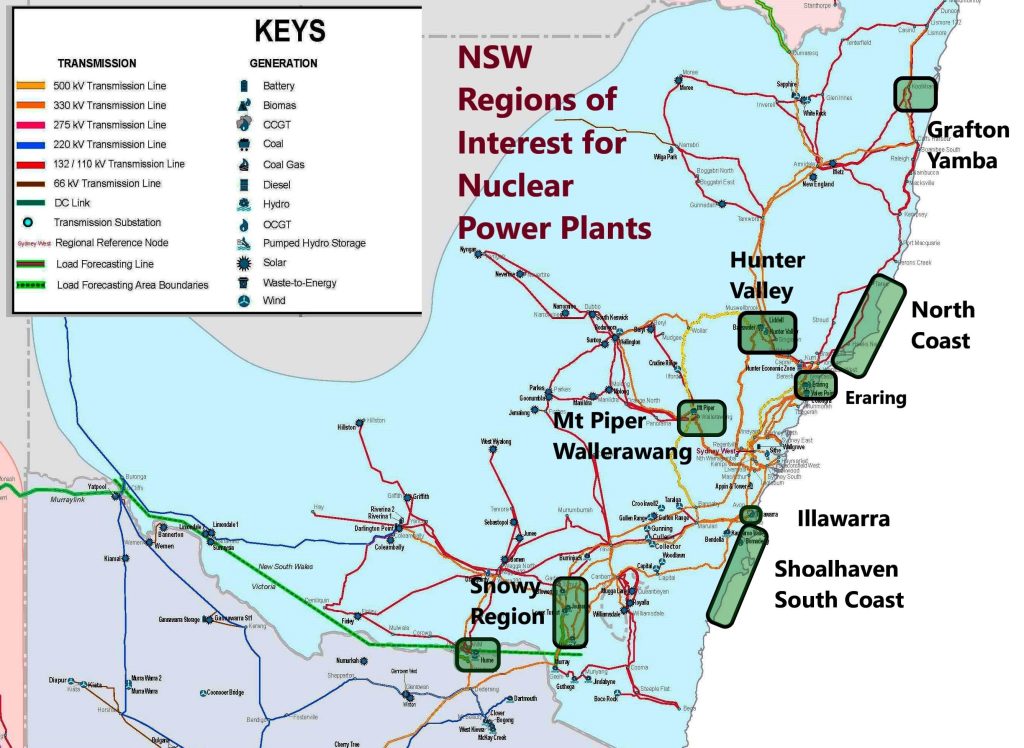
NSW Nuclear Power Plant locations
Edition 5, Revised 26/02/2025
Locations for Nuclear Power Plants in NSW
The Nuclear For Climate “Optimum Plan” for the NEM calls for 18GW of nuclear capacity in 2050 and 30GW by 2060. Based on existing demand the New South Wales proportion is about 38% of this requiring 7 GW in 2050 and 11 GW by 2060.
In New South Wales this could be achieved by a fleet of large nuclear power plants though depending on available water resources some inland sites may be more suited to small plants or SMR’s which have less than 300MW capacity:
Large Plants – By 2050, seven large 1GW, APR 1000 plants would provide 7GW of capacity. This would increase to eleven large plants by 2060. Large plants have pluses and minuses.
While large plants are lower cost per unit of capacity than small plants, they all need to be built in multiples at each site to achieve their greatest economies. For large plants this means the minimum actual installed capacity at a site would be 2GW which, though unlikely, could exceed the available cooling resources at an inland site. The option therefore exists to install smaller 300MW units should this occur.
To build 7GW of new nuclear by 2050 (and 11GW by 2060) will require construction of large plants at both inland and coastal locations. Some coastal sites will require a modest increase in transmission capacity to convey the energy through to the major load centres.
In the following image and tabulations we have included locations and suggested capacities for nuclear power plants at each site.
 The first Table 1 assumes that cooling resources will be available at these sites to meet the long term needs of the plants. Table 2 assumes greater constrains on cooling water availability which results in an increased number of small 300MW plants at a greater number of sites. May options and combinations are available.
The first Table 1 assumes that cooling resources will be available at these sites to meet the long term needs of the plants. Table 2 assumes greater constrains on cooling water availability which results in an increased number of small 300MW plants at a greater number of sites. May options and combinations are available.
Table 1 Unrestricted Water Availability
| Location |
2050 |
2060 |
|||
| Capacity MW | Number of Units | Capacity MW | Number of Units | Cooling Type | |
| Bayswater/Liddell | 3,000 | 3 | 3,000 | 3 | Seawater |
| Mt Piper/Wallerawang | 2,000 | 2 | 2,000 | 2 | Freshwater |
| Shoalhaven | 0 | 0 | 2,000 | 2 | Seawater |
| Illawarra | 0 | 0 | 0 | 0 | Seawater |
| Snowy/Murray | 0 | 0 | 0 | 0 | Fresh water |
| Grafton | 0 | 0 | 0 | 0 | River Estuary |
| Eraring | 2,000 | 2 | 4,000 | 4 | Seawater |
| Total | 7,000 | 7 | 11,000 | 11 | |
Table 2 – Restricted Water Availability
| Location |
2050 |
2060 |
|||
| Capacity MW | Number of Units | Capacity MW | Number of Units | Cooling Type | |
| Bayswater/Liddell | 2,000 | 2 | 2,000 | 2 | Seawater |
| Mt Piper/Wallerawang | 570 | 2 | 1,140 | 4 | Freshwater |
| Shoalhaven | 2,000 | 2 | 3,000 | 3 | Seawater |
| Illawarra | 570 | 2 | 570 | 2 | Seawater |
| Snowy/Murray | 0 | 0 | 855 | 3 | Fresh water |
| Grafton | 0 | 0 | 855 | 3 | River Estuary |
| Eraring | 2,000 | 2 | 4,000 | 4 | Seawater |
| Total | 7,140 | 10 | 10,710 | 15 | |
Locations for these plants have been chosen using the criteria listed in Site Selection
NSW and the National Grid
Transmission and distribution currently make up the largest share of our electricity bills. In NSW its of the order of 45% while in SA its around 68%. Our analysis shows that going to 100% renewable energy with wind and solar could see this component at least double in cost.
Using nuclear power plants especially with Large Nuclear Power Plants can make huge saving on the most expensive part of our electricity bills.
New sites will need to be located close by the grid.
A very detailed discussion of the challenges being faced by countries integrating different forms of energy generation onto their grids can be found at: Electricity Transmission Grids – World Nuclear Association
Cooling NSW Nuclear Plants
In New South Wales coal fired plants were constructed adjacent to available coal mines and other infrastructure.
New nuclear plants will where possible take advantage of the resource used for cooling at these plants. On the mid North Coast, Illawarra and South Coast this is sea water while in the Central Tablelands and Upper Hunter, fresh water has traditionally been used. Up in the Grafton region small nuclear power plants would use estuarine water cooling.
In an effort to reduce the environmental impact upon inland water resources, modern nuclear power plants are being designed to use a hybrid system of air and water cooling. During periods of low water availability the degree of air cooling can be increased though at a modest reduction in power output.
The tabulation shows the anticipated type of cooling at each plant
Australia’s long coastlines provide many options for locating nuclear power plants
To overcome issues surrounding temperature rises in inland locations cooling towers or mechanically driven systems known as hybrid and recirculating systems can be used. These are now the only option used in the United States under their EPA guidelines.
While recirculating systems don’t add heat to the river or lake, they do consume water through evaporation. In Australia the availability of sizeable inland rivers are limited though a number of large reservoirs such as Hume Reservoir or reservoirs in the Snowy could be studied for their suitability.
An excellent and detailed outline of the cooling options is available at: Cooling Power Plants | Power Plant Water Use for Cooling – World Nuclear Association
